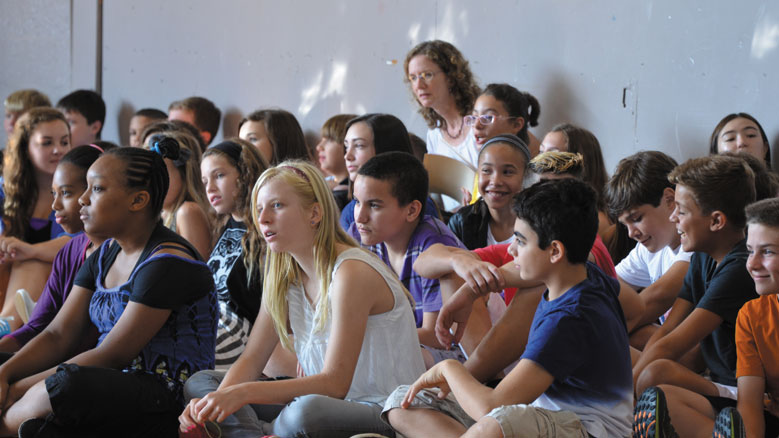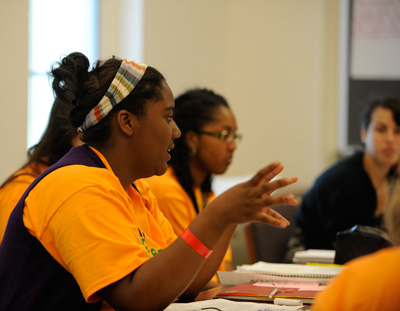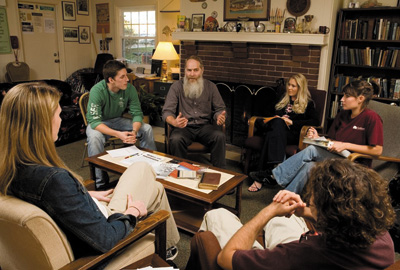
For me, the Quaker identity of institutions, especially academic ones, is an important and complex matter. Recently, the question has been raised in my yearly meeting, Southern Appalachian Yearly Meeting and Association (SAYMA): What makes an institution Quaker? While I have supported American Friends Service Committee and other Quaker institutions from the outside, I have also participated intimately in three Quaker academic institutions: Westtown School, a boarding school near West Chester, Pennsylvania; Earlham College in Richmond, Indiana, as a student; and Guilford College in Greensboro, North Carolina, as a teacher. Each of these formally identifies as Quaker, although in different ways, but more profoundly, each lives its Quakerism in the ways it attends to inwardness beneath all forms.
While all three institutions were formed by Quakers for the purpose of educating only Friends’ children to be taught by only Quaker teachers, the number of students, teachers, and administrators who are Friends has diminished considerably over the centuries, often to a small percentage. All Friends schools and colleges in America now depend, for their existence and for their flourishing, upon the participation of non-Quakers. Yet, they all identify as Quaker in actuality and not simply in heritage. How can they do this without a predominance, if not a totality, of Quakers?
 While Westtown, Earlham, and Guilford were all founded by Friends, they each have a different formal relationship to Quakerism. Earlham is owned by a yearly meeting (until recently by two yearly meetings, Western and Indiana, now only the former). Guilford has never been owned by a yearly meeting, but retains a 50-percent representation of Friends on the board of trustees. Westtown is not owned by Philadelphia Yearly Meeting but exists under its care, reporting to it annually. While these differing formal relationships identify the institutions as Quaker, what makes and keeps them Quaker is a distinctive way of academic life, which can be seen in various practices (everyday comportment, business procedures, worship, etc.). Invisible to the public eye, there is a Quaker ethos that reaches beneath policies and words and into the Friends spiritual orientation underlying them.
While Westtown, Earlham, and Guilford were all founded by Friends, they each have a different formal relationship to Quakerism. Earlham is owned by a yearly meeting (until recently by two yearly meetings, Western and Indiana, now only the former). Guilford has never been owned by a yearly meeting, but retains a 50-percent representation of Friends on the board of trustees. Westtown is not owned by Philadelphia Yearly Meeting but exists under its care, reporting to it annually. While these differing formal relationships identify the institutions as Quaker, what makes and keeps them Quaker is a distinctive way of academic life, which can be seen in various practices (everyday comportment, business procedures, worship, etc.). Invisible to the public eye, there is a Quaker ethos that reaches beneath policies and words and into the Friends spiritual orientation underlying them.
Some aspects of Quaker identity and behavior are discovered with shock by new students. When my wife-to-be transferred as a non-Quaker into Earlham, she was amazed (and knew something was different about this place) when she heard students addressing the student dean and even the president by first name. Only later did she learn that this was an expression of the Quaker witness to equality of persons and against hierarchical titles.
In my experience, public occasions at all three institutions always began with silence out of which speaking would emerge. My classes at Guilford began with a moment of silence which I, as the professor, made clear could be used in whatever ways felt appropriate to the student. If familiar with Quaker or other meditation, one could use it to center down. If unfamiliar, one could use it as an opportunity to bring the whole self into the classroom, to settle into a sense of expectancy, gathering courage to engage in the anticipated dialogue with me and fellow students about a text and the texture of one’s life.
Faculty meetings, student senates, trustee meetings, and other business meetings use Quaker procedure. Educating participants about how this is done is an ongoing task, especially with new people who have never experienced a Friends meeting for worship with attention to business. At Guilford, I remember new people often being confused about how in a faculty meeting there could be such a range of forcefully expressed differing opinions and then suddenly, so it seemed, there was a decision that everyone agreed with—as if the decision had been reached beforehand in the inner chambers of someone’s office. Also at Guilford, I remember the director of faculty development spending weeks in the fall explaining the Quaker business process and other matters of Quaker identity to new faculty. On occasion, part of faculty meeting was devoted to a Quaker teacher clarifying these matters. Sometimes, in the midst of heated discussions, the clerk or other Friends would clarify options in Quaker procedure: to lay the issue over for seasoning, to stand aside, to stand opposed. Or as things were turning from expression of disparate views toward the gathering of a sense of the meeting, Friends would offer procedural clarification of what was happening at the moment.

Other visible forms of Quaker identity include classes in Quakerism and the availability (sometimes a requirement) of Friends worship. Searching for Quakers to hire as teachers, administrators, and staff is an institutional commitment, sometimes pursued with passion, sometimes not. The ethical context of concern for peace, justice, and environmental responsibility is evident in various ways, in the curriculum as well as in the attitudes of teachers whether they are Friends or not (many of whom are attracted to teaching in Friends schools and colleges because of what they come to understand are Quaker testimonies).
Beneath all these visible practices and behaviors is the more fundamental way in which these institutions are Quaker. From the beginnings of Quakerism, Friends have insisted that a dimension of inwardness lies beneath all forms, both those publicly visible and those ideas, values, decisions, and principles held to in one’s own interiority—hence the use of silence in various ways throughout the day. Central to Quaker identity is the recognition of a dimension of depth and mystery that all persons have within. This inward teacher engenders courage in community: to speak one’s mind and heart, however different from what has already been said; to listen with compassion to others; to open to changing one’s mind rather than defending one’s initial stated position; and to engage creatively and collaboratively in achieving a sense of the meeting.
While this Quaker way of doing and being is an ethos more caught than taught, an ongoing effort needs to be made to describe, exhibit, and reflect on it as experienced; in this way, members of an academic community can interiorize Quaker identity. Non-Quakers can learn this. They do not need to become members of a meeting nor use Quaker or traditional religious language to understand it. While there have been times in the history of Friends that explicit forms have been used to make people conform, the center of Friends spirituality is waiting in silence and moving in word or deed as led in and from these depths.
An institution is Quaker if it attends to and seeks to live from such creative mystery. Friends in the academic community bear responsibility for articulating and nurturing this concept. Regardless of their self-understanding as religious or not, those who are not Friends can learn to participate fully and fruitfully in a Quaker academic community. In my experience at Guilford, it was often the “Quakerized” teachers and administrators—the ones who immersed themselves in the Quaker way without owning that identity—who contributed as significantly as members of a meeting to making and keeping Guilford a Friends institution.
I would say, therefore, that an institution is recognizably Quaker by the various forms through which it manifests itself, and even more fundamentally, through its spiritual orientation (acknowledged or not as spiritual by many of its participants). It is not the numbers of Friends nor the outward forms of Quaker authority and ownership but, dare I say, the spirit of the place that makes institutions (and you and me) Quaker.



Comments on Friendsjournal.org may be used in the Forum of the print magazine and may be edited for length and clarity.